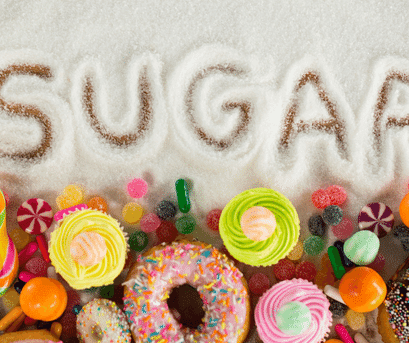After talking a bit the other week about what a ketogenic diet is, opening the door to a pretty interesting discussion with some patients about the body’s use of sugar, I thought this week it would be worth explaining about glycaemic responses.
A glycaemic response is an increase in blood glucose levels that occurs after eating carbohydrates.
When we digest our food, the carbohydrates in the food break down and become glucose, which passes from the digestive tract into the bloodstream.
The glucose now present in the blood causes the secretion of insulin from the pancreas – in the amount needed to get the glucose from the blood into the cells in the body, where it is used to generate energy.
This process – a glycaemic response – begins as soon as the food starts to be broken down, and then, usually about two hours after the meal, the glucose concentration drops back to a fasting level after being absorbed into the various tissue cells. The normal range of blood glucose levels during fasting is 70-100 mg per 100 cc.
A strong response is when the blood glucose concentration rises rapidly and to a high level, while a weak response is when the blood glucose concentration rises slowly and to a relatively low level. A low glycaemic response means lower insulin secretion and better control of blood sugar levels over time.
In the past, the common assumption was that simple sugars cause a stronger glycaemic response than complex sugars, but the truth is that a glycaemic response depends on many factors, including:
Type of carbohydrate: Potato starch, for example, leads to a glycaemic response that is identical to that of pure glucose, and although fructose and glucose are both simple carbohydrates, fructose has a weaker glycaemic response than glucose.
Processing of the food: Cooked food produces a stronger response than raw food, and pureed food creates a stronger response than whole food (apple puree will result in a stronger response than the whole apple). Foods that dissolve in the mouth (like rice crackers, for example) will usually break down into sugar faster and lead to a stronger glycaemic response.
Ripeness: Usually, the riper the food, the stronger the glycaemic response. For example, a less ripe kiwi – one that is firm and slightly sour – will lead to a weaker glycaemic response than a kiwi that is ripe – soft and sweet.
Dietary combinations: Food that is eaten with added vinegar or lemon juice will lead to a weaker response than the same food without the acidity. In addition, the addition of dietary fibre also moderates the glycaemic response of food, as well as the presence of protein and fat in food.
Differences between people: The glucose curve and the amount of insulin secreted in the body varies from person to person, and all the more so between a person who is diabetic and one who is not. In addition, the amount of enzymes secreted in the digestive tract and the rate of digestion of the digestive system also varies between people.
So a glycaemic response is an increase in blood sugar after eating.
What is the glycaemic index?
Every food that contains carbohydrates is examined by the glycaemic index according to how fast it raises our blood glucose levels while it is being digested, compared to consuming the same amount of pure glucose. For the purpose of creating the index, pure glucose is determined to have a glycaemic index of 100. When a person is given a certain amount of pure glucose and the blood glucose level is checked every half hour for two hours, a glycaemic response curve is obtained which is considered to be 100%.
When the glycaemic index is high, food is digested quickly and raises the blood glucose level quickly and to a large degree, and the body is forced to secrete a lot of insulin to lower the sugar level. Carbohydrates that break down slowly, which have a low glycaemic index, release glucose into the bloodstream gradually.
Carbohydrates with a glycaemic index above 70 are considered to have a high glycaemic index (examples: white bread, cornflakes, beets, white rice …); carbohydrates with a glycaemic index below 55 are considered to have a low glycaemic index (examples: beans, rye, peanuts, cherries …). Foods that do not contain or contain very few carbohydrates, such as oils and fats, meat, fish, or cheeses do not get a score in the glycaemic index.
This is important because while we do need carbohydrates for energy, we need “the right kind” of carbohydrates. When we consume foods with a high glycaemic index, they break down quickly into sugar in the body, and we get the familiar feeling of a “sugar high” – the feeling of an burst of energy, followed by the “drop” and the feeling of fatigue, headaches, cravings for sweets, and binge eating. Too much blood sugar can be problematic for our body, and requires urgent intervention by releasing insulin that removes the sugar from the blood and into the cells, where it is used for energy purposes, while the excess is stored or converted into fat. About an hour after eating something with a high glycaemic index, we need another dose of energy, and if we eat something with a high glycaemic index again, this cycle will repeat itself. This response disrupts our natural appetite, causing us to crave sweet things because we cannot feel true satiation. If this vicious cycle is repeated too many times, it may worsen to a state of insulin resistance – a condition in which we need increasing amounts of insulin in order to reduce blood glucose levels. Insulin resistance can lead to high blood pressure, diabetes, high cholesterol levels, and fat storage (note that all of these symptoms together constitute the metabolic syndrome).
The carbohydrates we need are those with a low glycaemic index, which encourage slow and moderate insulin secretion. These carbohydrates contribute to a longer feeling of satiation. The body has time to use glucose in a methodical way that allows for the regular production of energy. Maintaining stable and moderate levels of sugar in the bloodstream over time contributes to optimal utilization of the food components for the purpose of metabolism, and thus contributes to weight loss. When our nutrition has a low glycaemic index, we can see a positive effect on all body functions – from the digestive system to heart and skin health. A diet with a low glycaemic index supports maintaining a healthy weight, and has been found to reduce the risk of stroke, diabetes, and even breast cancer and Alzheimer’s.
The glycaemic index method is not perfect. First of all, it examines the glycaemic index of each food individually, and it will be difficult to predict the glycaemic index of an entire meal. In addition, we already know that if we put lemon juice on the salad and cook the vegetables for less time, our glycaemic response will be different than if we did not add lemon and cooked the vegetables to death.
Still, using the glycaemic index and our knowledge of glycaemic responses when building a menu can be significant when the goal is to balance blood sugar levels or lose weight.
Note that in addition to consuming carbohydrates with a low glycaemic index, eating legumes and coarse grains, unprocessed and rich in protein, contributes to a moderate glycaemic response. In addition, if we want our blood sugar levels to be balanced throughout the day, we should eat a number of small meals in the course of the day, rather than 3 large meals.



